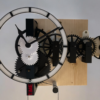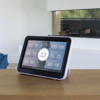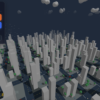Firstly apologies, the blog has been sat on the sidelines waiting for a post while i have been in a whirlwind of a three weeks. The good news is the blog is back, in short, we have been in the process recently of securing grants, launching a new Masters of Research course here at the Centre for Advanced Spatial Analysis at University College London and presenting current research to the British Science Festival and the associated press conference.
Stuart Eve here in CASA has been working away in the Unity gaming engine in terms of Augmented Reality applications for the iPhone and iPad. As Stewart himself notes it is surprisingly successful and with at least 3 different ways of getting 3D content to overlay on the iOS video feed (Qualcomm, StringAR and UART). He has been attempting to load 3D content at runtime, so that dynamic situations can be created as a result of user interaction – rather than having to have all of the resources (3D models, etc.) pre-loaded into the app. This not only saves on file size of the app, it also means that the app can pull real-time information and data that can be changed by many people at once.
We have a bit of a ‘thing’ about 3D audio soundscapes. Over recent years it has become increasingly possible to analyse audio content and visualise it within a 3D package, there are solutions for most suites out there from 3D Max, Cinema 4D and through to Processing.
The ‘audio driven landscape’ below by flight404 is one of the best examples we have seen, written in processing it makes use of the Sonia Sound Library:
We hope to grab some time to dive into this ourselves with a view of determining the ‘Sound of the City’….
Richard Milton here in CASA has released a new feature on the MapTube website today which will make it easier to create new maps from data in CSV files. The new update to MapTube adds a graphical user interface which allows the user to upload a data file, choose a colour scale and publish the map on MapTube directly. As Richard states, one of the driving forces behind this was the idea that creating a map should be simple enough that you could do it using an iPad. Data on the London Datastore is in the correct format, so you can copy the CSV link directly from the site, which is exactly what has been done in the above image. Richard has created a YouTube clip showing the whole process:
Constituency,Party,PartyCode,Change
Aberavon,LAB,1,LAB Hold
Aberconwy,CON,2,CON Gain
etc...
Government Office Regions (UK) (GOR)
Lower level super output areas (UK) (LSOA)
Medium level super output areas (UK) (MSOA)
Output Areas (UK) (OA)
Postcode Districts (UK) (PostcodeDistricts)
County and Unitary Authority (UK) (CountyUA and ONSCountyUA)
Districts (UK) (Districts and ONSDistricts)
Census Area Wards (UK) (CASWards)
World Borders 2010 (WorldBorders2010ISO2 and ISO3 using the ISO country codes)
Parliamentary Constituencies 2010 (UK) (PCON2010)
The underlying technology is used on the SurveyMapper site and for other real-time visualisations like http://bigdatatoolkit.org/2011/07/26/1yeartogo/ which shows tweets using the #1yeartogo hashtag for the London 2012 Olympics.
We aim to enhance this further over the coming months as MapTu
be is at the heart of GEMMA (Geographical Engine for Mass Mapping Applications), its an interesting step forward in rapid visualisation from data portals. Thanks as ever go to Richard for his work on MapTube and its every increasing number of users.



